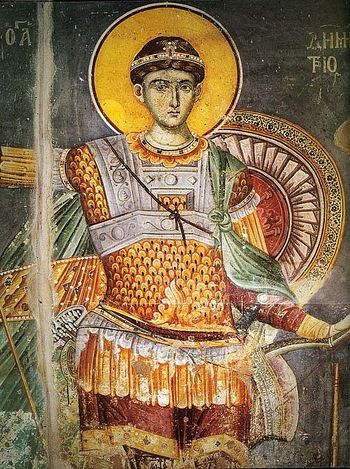The earliest written accounts of his life were compiled in the 9th century, although there are earlier images of him, and the 7th-century Miracles of Saint Demetrius collection. According to these early accounts, Demetrius was born to pious Christian parents in Thessaloniki, Macedonia in 270.
According to the hagiographies, Demetrius was a young man of senatorial family who became proconsul of the Thessalonica district. He was run through with spears in around 306 in Thessaloniki, during the Christian persecutions under the emperor Galerius, which matches his depiction in the 7th-century mosaics.
Most historical scholars follow the hypothesis put forward by Bollandist Hippolyte Delehaye (1859–1941), that his veneration was transferred from Sirmium[5] when Thessaloniki replaced it as the main military base in the area in 441/442 AD. His very large church in Thessaloniki, the Hagios Demetrios, dates from the mid-5th century.[6] Thessaloniki remained a centre of his veneration, and he is the patron saint of the city.
After the growth of his veneration as saint, the city of Thessaloniki suffered repeated attacks and sieges from the Slavic peoples who moved into the Balkans, and Demetrius was credited with many miraculous interventions to defend the city. Hence later traditions about Demetrius regard him as a soldier in the Roman army, and he came to be regarded as an important military martyr.
Most historical scholars follow the hypothesis put forward by Bollandist Hippolyte Delehaye (1859–1941), that his veneration was transferred from Sirmium[5] when Thessaloniki replaced it as the main military base in the area in 441/442 AD. His very large church in Thessaloniki, the Hagios Demetrios, dates from the mid-5th century. Thessaloniki remained a centre of his veneration, and he is the patron saint of the city.
After the growth of his veneration as saint, the city of Thessaloniki suffered repeated attacks and sieges from the Slavic peoples who moved into the Balkans, and Demetrius was credited with many miraculous interventions to defend the city. Hence later traditions about Demetrius regard him as a soldier in the Roman army, and he came to be regarded as an important military martyr.
Unsurprisingly, he was extremely popular in the Middle Ages. Disputes between Bohemond I of Antioch and Alexios I Komnenos appear to have resulted in Demetrius being appropriated as patron saint of crusading.
Most scholars still believe that for four centuries after his death, Demetrius had no physical relics, and in their place an unusual empty shrine called the "ciborium" was built inside Hagios Demetrios. What were purported to be his remains subsequently appeared in Thessaloniki, but the local archbishop John, who compiled the first book of the Miracles ca. 610, was publicly dismissive of their authenticity.[8] The relics were assumed to be genuine after they started emitting a liquid and strong-scented myrrh. This gave Demeterius the epithet Myroblyte.

